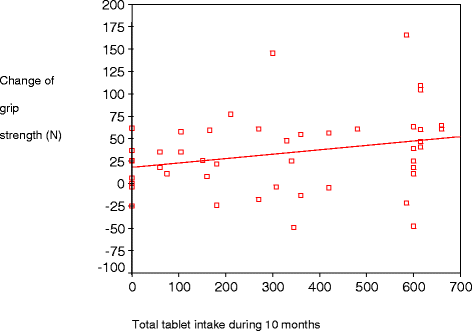Long-term adherence and effects on grip strength and upper leg performance of prescribed supplemental vitamin D in pregnant and recently pregnant women of Somali and Swedish birth with 25-hydroxyvitamin D deficiency: a before-and-after treatment study
- PMID: 27846821
- PMCID: PMC5109741
- DOI: 10.1186/s12884-016-1117-3
Long-term adherence and effects on grip strength and upper leg performance of prescribed supplemental vitamin D in pregnant and recently pregnant women of Somali and Swedish birth with 25-hydroxyvitamin D deficiency: a before-and-after treatment study
Abstract
Background: Muscular weakness and severe vitamin D deficiency is prevalent in Somali (veiled) pregnant women, Sweden. The study aims here were to explore adherence to prescribed supplemental vitamin D in new mothers with vitamin D deficiency and its effects on grip strength and upper leg performance in Somali (target group TG) and Swedish women (reference group RG) from spring through winter.
Methods: A before- and after study was designed. A cross-sectional sample of women in antenatal care with serum 25-OHD ≤50 nmol/L were prescribed one or two tablets daily (800 or 1600 IU vitamin D3 with calcium) for 10 months. Reminders were made by Somali nurses (TG) or Swedish doctors (RG). Baseline and 10 month measurements of plasma nmol/L 25-OHD, maximal grip strength held for 10 s (Newton, N) and ability to squat (yes;no) were done. Total tablet intake (n) was calculated. Outcome variables were changes from baseline in grip strength and ability to squat. Predicting variables for change in grip strength and ability to squat were calculated using linear and binary regression in final models. Undetectable 25-OHD values (<10 nmol/L) were replaced with '9' in statistic calculations.
Results: Seventy-one women (46 TG, 1/3 with undetectable baseline 25-OHD; 25 RG) participated. At the 10-month follow up, 17% TG and 8% RG women reported having refrained from supplement. Mean 25-OHD increased 16 to 49 nmol/L (TG) and 39 nmol/L to 67 nmol/L (RG), (both p < 0.001). Grip strength had improved from 153 to 188 N (TG) (p < 0.001) and from 257 to 297 N (RG) (p = 0.003) and inability to squat had decreased in TG (35 to 9, p < 0.001). Intake of number of tablets predicted increased grip strength (B 0.067, 95%CI 0.008-0.127, p = 0.027). One tablet daily (>300 in total) predicted improved ability to squat (OR 16; 95% CI 1.8-144.6).
Conclusions: Adherence to supplemental vitamin D and calcium should be encouraged as an even moderate intake was associated to improved grip strength and upper leg performance, which was particularly useful for the women with severe 25-OHD deficiency and poor physical performance at baseline.
Trial registration: ClinicalTrials.gov Identifier: NCT02922803 . Date of registration: September 28, 2016.
Keywords: Adherence; Grip strength; Multicultural care; Physical performance; Pregnancy; Somalia; Vitamin D.
Figures
Similar articles
-
Physical performance and 25-hydroxyvitamin D: a cross-sectional study of pregnant Swedish and Somali immigrant women and new mothers.BMC Pregnancy Childbirth. 2013 Dec 17;13:237. doi: 10.1186/1471-2393-13-237. BMC Pregnancy Childbirth. 2013. PMID: 24345271 Free PMC article.
-
Positive impact on vitamin D related lifestyle of medical advice in pregnant Somali-born women and new mothers: a mixed method study in Swedish primary care.BMC Public Health. 2021 Feb 5;21(1):297. doi: 10.1186/s12889-021-10277-y. BMC Public Health. 2021. PMID: 33546641 Free PMC article.
-
The effect of monthly 50,000 IU or 100,000 IU vitamin D supplements on vitamin D status in premenopausal Middle Eastern women living in Auckland.Eur J Clin Nutr. 2015 Mar;69(3):367-72. doi: 10.1038/ejcn.2014.264. Epub 2014 Dec 10. Eur J Clin Nutr. 2015. PMID: 25491499 Clinical Trial.
-
Vitamin D status predicts hand-grip strength in young adult women living in Auckland, New Zealand.J Steroid Biochem Mol Biol. 2013 Jul;136:330-2. doi: 10.1016/j.jsbmb.2012.11.015. Epub 2012 Dec 7. J Steroid Biochem Mol Biol. 2013. PMID: 23220545 Review.
-
Influence of mineral and vitamin supplements on pregnancy outcome.Eur J Obstet Gynecol Reprod Biol. 2012 Oct;164(2):127-32. doi: 10.1016/j.ejogrb.2012.06.020. Epub 2012 Jul 6. Eur J Obstet Gynecol Reprod Biol. 2012. PMID: 22771225 Review.
Cited by
-
Effects of vitamin D supplementation on muscle strength in middle-aged and elderly individuals: a retrospective, propensity score-matched study.Front Nutr. 2024 Aug 23;11:1450265. doi: 10.3389/fnut.2024.1450265. eCollection 2024. Front Nutr. 2024. PMID: 39246393 Free PMC article.
-
Assessment of physical fitness during pregnancy: validity and reliability of fitness tests, and relationship with maternal and neonatal health - a systematic review.BMJ Open Sport Exerc Med. 2022 Sep 23;8(3):e001318. doi: 10.1136/bmjsem-2022-001318. eCollection 2022. BMJ Open Sport Exerc Med. 2022. PMID: 36172399 Free PMC article.
-
From being restrained to recapturing vitality: non-western immigrant women's experiences of undergoing vitamin D treatment after childbirth.Int J Qual Stud Health Well-being. 2019 Dec;14(1):1632111. doi: 10.1080/17482631.2019.1632111. Int J Qual Stud Health Well-being. 2019. PMID: 31232674 Free PMC article.
-
Ideal vitamin D and handgrip strength counteracts the risk effect of APOE genotype on dementia: a population-based longitudinal study.J Transl Med. 2023 May 29;21(1):355. doi: 10.1186/s12967-023-04195-3. J Transl Med. 2023. PMID: 37246226 Free PMC article.
-
Preterm-Born Young Women Have Weaker Hand Grip Strength Compared to Their Full-Term-Born Peers.Children (Basel). 2023 Dec 7;10(12):1898. doi: 10.3390/children10121898. Children (Basel). 2023. PMID: 38136100 Free PMC article.
References
-
- Hoppeler H, Fluck M. Normal mammalian skeletal muscle and its phenotypic plasticity. J Exp Biol. 2002;205(Pt 15):2143–2152. - PubMed
-
- Ferrando AA, Lane HW, Stuart CA, Davis-Street J, Wolfe RR. Prolonged bed rest decreases skeletal muscle and whole body protein synthesis. Am J Physiol. 1996;270(4 Pt 1):E627–E633. - PubMed
-
- Visser M, Deeg DJ, Lips P, Longitudinal Aging Study A Low vitamin D and high parathyroid hormone levels as determinants of loss of muscle strength and muscle mass (sarcopenia): the Longitudinal Aging Study Amsterdam. J Clin Endocrinol Metab. 2003;88(12):5766–5772. doi: 10.1210/jc.2003-030604. - DOI - PubMed
MeSH terms
Substances
Associated data
LinkOut - more resources
Full Text Sources
Other Literature Sources
Medical
Miscellaneous


